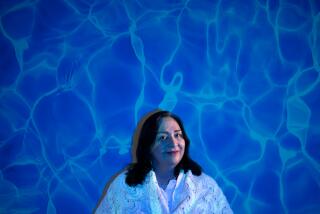Many With Multiple Sclerosis Are Hypersensitive to Heat : Spacesuits Ease Life for Disease Victims
- Share via
FARMIMGTON, Conn. — Multiple sclerosis patient Ed Wojcik lay in his bed in despair, unable to move his legs, focus his eyes or speak intelligibly.
Once again, the summer heat was taking its toll, but Wojcik’s mind was active.
“If astronauts can keep cool and comfortable during space walks despite searing solar radiation, maybe something can be done for me,” the retired engineer figured.
Researchers are hoping that Wojcik’s brainstorm may provide relief for victims of the chronic disease of the central nervous system--most of whom are hypersensitive to heat--enabling them to lead normal lives in all climates.
300 Feet of Tubing
Wojcik, 44, said that he had noticed temporary relief from the symptoms of multiple sclerosis when attending his son’s hockey games.
“The arena was 30 or 40 degrees,” he said. “I’d feel so much better, I started thinking about the spacesuits and how they keep astronauts cool.”
Wojcik contacted a friend, Jack Piela, an engineer in the space systems department of the Hamilton Standard division of United Technologies, the firm that makes the spacesuits and life support systems for the National Aeronautics and Space Administration.
The one-piece cooling suit made of spandex contains more than 300 feet of plastic tubing to carry water around the body but weighs only 6.5 pounds.
With the company’s go-ahead, Piela brought one of the suits to Wojcik’s South Windsor home.
“I’ll never forget it,” Piela said. “It was toward the end of July. The temperature was 90 degrees. Ed was lying in his bed, virtually incapacitated from the waist down even though an air conditioner was on.
“I hauled him from the bedroom to the kitchen and hooked up the suit,” Piela said. “After 20 to 30 minutes, he could feel the cooling sensation of the water on his legs. After an hour, his legs voluntarily moved and, by the end of the second hour, he could stand up and move about.”
Piela said that his friend’s speech began to clear and his eyes focused.
Regained Muscle Control The cooling effect of the garment had reduced Wojcik’s body temperature, and he regained control of his leg muscles. “I hooked 25 feet of hosing to the kitchen faucet, with more hosing returning the circulated water to the drain,” Piela said. “The astronauts use a closed circuit system, but, other than that, the concept is the same.
“Our prototype worked,” Piela said. “The temperature of the water was 60 to 65 degrees, the same as the water used in the spacesuits. Our kitchen experiment paid off.”
“I felt as well as I did in the hockey rink,” Wojcik said, “and wore the suit for two or three hours a day.”
Each time, Piela documented the results. He said that the experiments were so encouraging that he asked University of Connecticut Health Center officials whether they were interested in testing the concept further.






